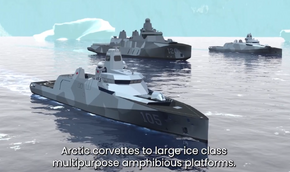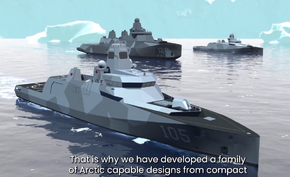As people may have missed it, Chantier Davie released a video a few days ago showing off the work they are doing on a Polar Icebreaker for the Canadian Coast Guard, but also showed off what looks to be their offerings for the Continental Defence Corvette program. They deleted the video shortly after, but not before some people took screenshots. I thought these might interest folks, so I am sharing them here.
There seems to be two designs, one labeled 105 and the other 120. I would assume these refer to their overall length in metres, but I'm unsure. The smaller corvettes look relatively modern and stealthy, with perhaps some considerations put forward for northern operations. It features a 57mm Bofors, 16 VLS cells of some kind, likely 4-8 NSM amidships, RAS capable, torpedo tubes, a flight deck, boat/small mission bay, fixed panel array mast, gun control director, helipad of some kind and some section under the helipad available for payloads? The bigger design is a bit more unique, it looks to have both a mast top rotating array alongside fixed array panels on the mast. A 76mm gun is present with potentially some VLS behind it, a Millennium gun is mounted aft, I see what looks like NSM canisters amidships, there are more substantial boat/mission bays amidships, a clearly larger helipad, a stepped open stern for cargo and most prominently, a bow seemingly designed for some not insubstantial icebreaking capability.
Very curious that they deleted the video, perhaps somebody shared this before they were supposed to?
View attachment 53453
View attachment 53452




